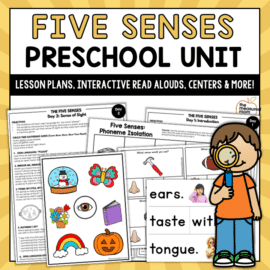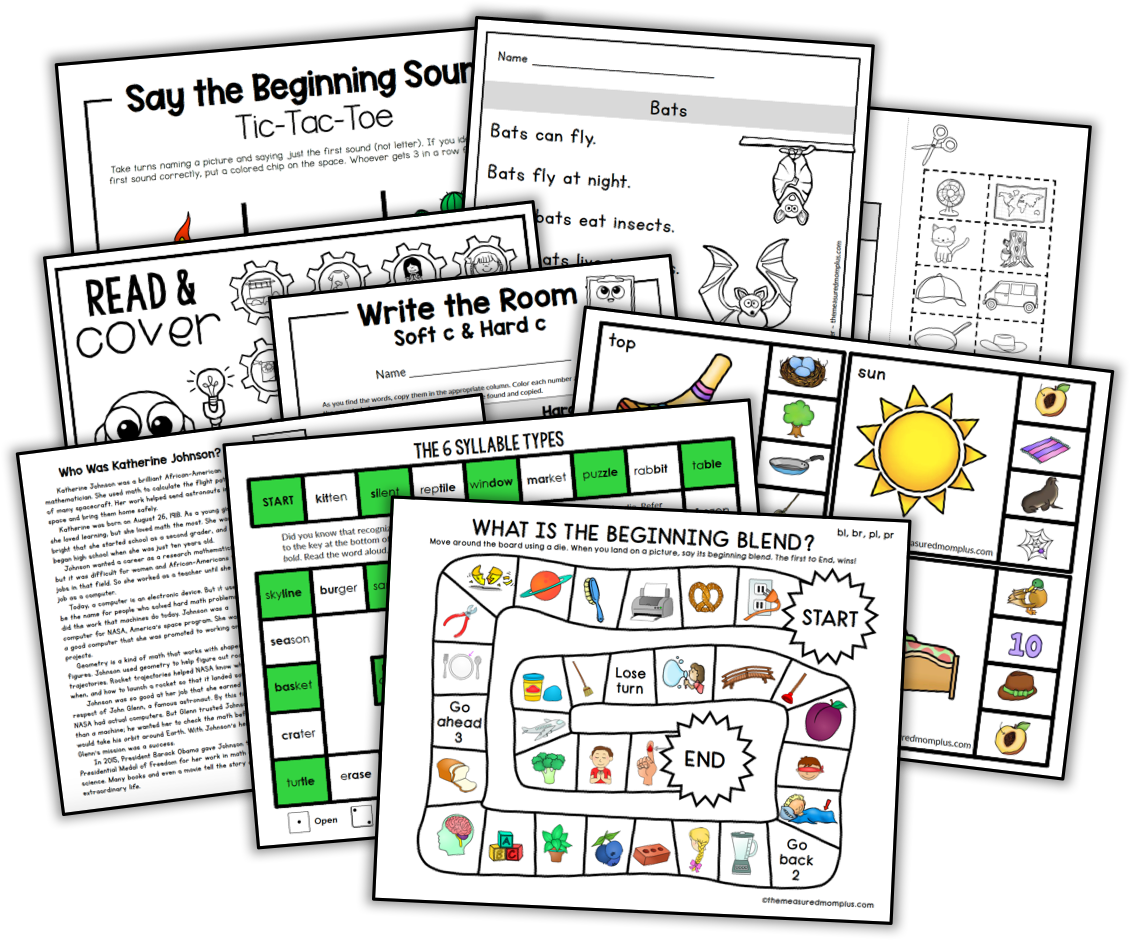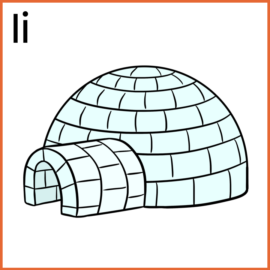Are you doing a unit about the five senses? You’ll love this list of books to read alongside your activities!

Welcome to a gigantic book list for the five senses! I’ll start by sharing some books that tell about the five senses all at once. Then I’ll share both fiction and nonfiction titles for exploring each sense one by one.
Cold, Crunchy, Colorful: Using Our Senses, by Jane Brockett
This book with large, colorful photographs gave us a lot to talk about and was a great introduction to the five senses. It would make an excellent read aloud at Circle Time!
My Five Senses, by Margaret Miller
If you can look past the dated photographs (those nineties outfits went out of style so fast), this book is also a nice introduction to the five senses. Hearing it once was enough for my preschooler, but the simple text meant he could almost “read” it for me. I always call that a win!
My Five Senses, by Aliki
This is a lovely book with delightful illustrations, a simple introduction to the five senses, and an explanation of how you can use more than one sense at a time.
The Magic School Bus Explores the Senses, by Joanna Cole
This is a book in the Magic School Bus series, in which a zany teacher takes her class on extraordinary field trips. In this book the children explore the inside of an eye, an ear, a tongue, and a dog’s nose. These books are a little long for me and might contain too much information for younger preschoolers. They work best as “on the couch” books rather than books read to a group. My own kids can’t get enough of The Magic School Bus!
You Can’t Smell a Flower with Your EAR! by Joanna Cole
This is a longer book which may be best for early elementary kids to read on their own, but it also makes a nice read aloud for preschoolers. If it’s too long for your audience, you may need to skip over some of the details.
Hearing
The Listening Walk, by Paul Showers
In this colorful book, a father and daughter take a walk while listening to all the sounds around them. From the noisy jackhammer to the quiet crickets and bees, there’s a lot to hear! I love that this book encourages children to be still and observe their world. After reading, follow up with a listening walk of your own!
Dog’s Noisy Day, by Emma Dodd
This simple story about a dog who visits a friendly farm will be most appealing to toddlers and young preschoolers. The pictures are great, but the animal sounds get a little boring for older listeners.
Hearing (The Five Senses), by Rebecca Rissmam
The five senses series by Rebecca Rismann is a real treasure. The collection is worth investing in for a preschool or kindergarten classroom library!
Hearing Things, by Allan Fowler
If you’ve read my other book lists you know I love Allan Fowler’s nonfiction books. In my opinion his five senses series isn’t as great as some of the others, but my preschooler still enjoyed this one.
Too Loud Lily, by Sofie Laguna
My Three really loved this darling, entertaining book about a hippopotamus who has only one volume: LOUD. (This may be because we are always telling him to use his inside voice!) Lily’s family is constantly telling her she is too loud, so she loves her boisterous new drama teacher who encourages Lily to speak, dance, and sing LOUDER. It’s in the class play that Lily truly shines!
When Lions Roar, by Robie H. Harris
This book is about a little boy who is afraid of loud noises, but comforts himself by sitting down and telling “the scary” to go away. I’m not crazy about the illustrations, and my son didn’t connect with it- but it might begin an interesting conversation about sounds.
Hearing (Five Senses Series), by Maria Rius
Except for the diagram and explanation at the end of the book, this is a very simple book that won’t provide any big science lessons. But it will inspire conversation about sounds you’ve heard and which are your favorite and not so favorite.
Bark, George, by Jules Feiffer
If you haven’t read this classic, you need to reserve it at your library right away. George the puppy’s mother instructs him to bark, but he makes all the wrong animal noises. Exasperated, his mother takes him to the vet – who reaches down his throat and pulls out a cat, a dog, and a cow… But the surprise ending is the funniest part!
Horton Hears a Who! by Dr. Seuss
Horton the elephant hears a small sound from a speck of dust, which turns out to be a tiny community called Whoville. Horton takes it on himself to protect the Whos because “a person’s a person, no matter how small.” At the end of the book, the Whos must shout with all their might to save their village. You might appreciate checking this book out from the library from time to time instead of owning it; it is very long. An audio version with Dustin Hoffman as narrator is wonderful to listen to in the car.
Listen Buddy, by Helen Lester
Even though Buddy the rabbit has big, beautiful ears, he’s a terrible listener. He mishears everything his parents say, which leads to some delightfully hilarious situations. A fun one!
Too Much Noise, by Ann McGovern
This is the classic tale of a man who can’t stand the noises made by his old house. He visits a wise man, who advises him to bring a cow in… and a horse… and other animals, until the noise is so loud the man is going crazy. Finally, the wise man tells him to take all the animals out. Suddenly the old house’s creaky noises are a welcome, comforting sound!
Tasting
Tasting Things, by Allan Fowler
If you can get past the weird cover of this book, it’s a great introduction to the sense of taste.
Gregory the Terrible Eater, by Mitchell Sharmat
Gregory the goat is a terrible eater. He won’t eat garbage! Instead he likes fruits, vegetables, meat, and other disgusting things. What will his parents do? We love the twist in the middle and the satisfying ending.
Too Pickley, by Jean Reidy
This book is a quick read which may help kids see the absurdity of refusing every food. The food is too fishy, too slimy, too slurpy, too bubbly… you get the idea. Not a phenomenal piece of children’s literature, but one to find at the library if you’d like to supplement your five senses unit.
Tony Baroni Loves Macaroni, by Marilyn Sadler
My Three’s favorite food is macaroni and cheese (we make a variation of this recipe), so it was no surprise that he loved this book about a boy who eats macaroni and cheese for every meal. No matter what other pasta his Nonna prepares, “Tony Baroni, he loved macaroni. He ate it with butter. He ate it with cheese. He ate it for breakfast, he ate it at noon, then ate it for dinner with a a big serving spoon.” A fun book!
Food ABC, by Amanda Doering
We enjoyed this collection of food photographs from A-Z and especially liked the conversational style of the book. “Ding-dong! The pizza is here.” and “Being upside down is lots of fun. Just ask this upside down cake.”
The Gingerbread Man, by Jim Aylesworth
Any version of this fairy tale will do when teaching about the sense of taste, but we enjoy this one because of the vintage illustrations and rhyming dialogue. “No! No! I won’t come back! I’d rather run than be your snack!” The cow, pig, and fox walk upright and are fully dressed – which is a little weird-looking and takes some getting used to. But I think it adds to the book’s charm.
The Seven Silly Eaters, by Mary Ann Hoberman
In this book Mrs. Peters has seven children — each of whom will eat (or drink) only one particular food. Poor Mrs. Peters is worn to the bone cooking homemade oatmeal, baking homemade bread, squeezing lemons for lemonade and peeling apples for applesauce. At the end of the book the family discovers a recipe that everyone will eat.
The Very Hungry Caterpillar, by Eric Carle
This is one of those classic children’s books that every preschooler should hear – and what better time than during your five senses unit? We love reading what the hungry caterpillar eats (and eats and eats) until he builds a chrysalis and turns into a butterfly.
Stone Soup, by Marcia Brown
You probably know the old folktale about the hungry soldiers who visit a town and ask for food. All the villagers claim they have nothing to share. But when the soldiers begin to make soup from a stone and remark how wonderful it would taste if only it had a few potatoes (and carrots, onions, etc.) the villagers find whatever is asked for. At the end they marvel at the tasty soup made from a stone! This classic book won the Caldecott Medal (for best pictures) in 1947.
Taste (The Five Senses Series), by Maria Rius
This is another in the Five Senses series by Maria Rius. It has simple text and sweet illustrations. Admittedly it wasn’t a hit with my preschooler. When I tried to read it again a different day, he protested. “We read this one already!”
Tasting, by Rebecca Rissman
Like the other books in this excellent series, Tasting begins with a general discussion of the five senses and then tells more about this specific sense. One to own!
Yoko, by Rosemary Wells
Yoko’s classmates make her feel strange and weird by the comments they make about her Japanese lunch. When the teacher hosts an international food day to help children appreciate other cultures, it doesn’t exactly work. But when Timothy discovers that he loves sushi, Yoko makes a new friend.
Smelling
Smelling Things, by Allan Fowler
This book doesn’t go into the science of the sense of smell, but it will give your preschooler things to think and talk about. As far as nonfiction books go, it isn’t one of Fowler’s best. But it’s a good choice for a young preschooler.
Gladys Goes Out to Lunch, by Derek Anderson
This picture book is a favorite book of all my kids, even the older ones. Gladys the Gorilla loves bananas and eats them for every meal. But one day she smells something better, so she leaves the zoo and follows the scent. She finds a pizzeria, a fancy French cafe, and an ice cream stand. But her nose finally leads her back to the zoo, where she finds banana bread on a zoo cart.
The Story of Ferdinand, by Munro Leaf
Ferdinand is different than the other bulls. Instead of running, leaping, and fighting, he likes to sit quietly under the cork tree and smell the flowers. One day, however, he sits on a bee. He jumps and snorts and hurls himself around — impressing the rodeo men who take him to be in a bullfight. But when Ferdinand enters the arena, he just sits and smells the flowers. This is a treasure of a book and one to try again later if your preschooler doesn’t like it the first time.
Nosy Rosie, by Holly Keller
Rose is a sweet little fox who can help her family find anything they’re looking for with her excellent sense of smell. But when they start calling her “Nosy Rosie,” she refuses to find anything. Finally her family learns that “Rose is just Rose.”
Farley Follows His Nose, by Lynn Johnston
Featuring Farley from the comic strip For Better or for Worse, this picture book has Farley following his nose all around the neighborhood – from a child’s birthday party to the garbage truck and a pizza delivery. This was a big hit with my preschooler, who immediately pronounced, ” I LOVE that book!”
Big Smelly Bear, by Britta Teckentrup
No one will go near Big Smelly Bear except flies – because he refuses to take a bath. But when he has an itch he can’t reach and no one will come near him, he finally takes a bath in the pond. The clean bear even makes a new friend in Big Fluffy Bear.
Smelling (The Five Senses Series), by Rebecca Risman
This series’ simple text and vivid photographs make it a winner. In this book children learn that their nose can smell different scents, and some scents are dangerous.
Smell (Five Senses Series), by Maria Rius
Unlike Risman’s series, this one is quite simple and conversational. While it is probably best for toddlers and young preschoolers, it can begin simple conversations with older preschoolers as well: “What is your favorite smell? What’s a smell that could signal something dangerous? What are some smells you don’t like?”
Seeing

Brown Bear, Brown Bear, What Do You See? by Eric Carle
At our house this book is enjoyed so much by our toddlers that our children are bored with it by preschool. But I couldn’t leave out this classic. After they’re familiar with it, young children will enjoy “reading” along.
Duck! Rabbit! by Amy Krouse Rosenthal
This is a unique book about an animal that could be either a duck or a rabbit, depending on how you look at it (just check out the cover!). The book is clever, short, and engaging – a fun read for both parents and kids of all ages.
Look! Look! Look! by Tana Hoban
This is one of a number of wordless book by Hoban, featuring her striking photographs. In this book children peek through a square cut out and try to guess the mystery animal or object. They confirm their guess by flipping the page. Many of Hoban’s books were published in the 70’s and 80’s, but even with the dated photographs they are still excellent for teaching early concepts to children.

Seeing, by Rebecca Rismann
In this simple book, children learn how to keep their eyes safe, how some people wear glasses to see better, and how some people do not see at all.

Sight (Five Senses Series), by Maria Rius
I like the lovely watercolors and European style illustrations in this series. Again, the text isn’t very deep and may bore older preschoolers and kindergartners.
Touching

The Blind Men and the Elephant, by Karen Backstein
I really enjoyed this easy reader version of the tale in which six blind men go to the prince’s palace to meet their first elephant. Each feels a different part of the animal and has an entirely different idea about what it feels like. To one, it feels like wall, to another a snake, to another a sword, etc. This book is a great introduction to the sense of sight, but you can also get some deeper meanings from the book if you’re so inclined.

Seven Blind Mice, by Ed Young
“It’s a pillar,” says one. “It’s a fan,” says another. Like The Blind Men and the Elephant ,the seven blind mice investigate the strange animal by the pond. They each have a different idea about what it could be. Finally, the seventh mouse explores the whole animal and helps them understand the truth. This is a popular book, but I admit that my preschooler and I weren’t struck by it.
I Feel A Foot! by Maranke Rinck & Martijn van der Linden
This is yet another variation on the blind man and the elephant fable. A group of animals is awakened by night noises, and each of them feels a part of the elephant, trying to guess what it is. Each animal feels something that feels like itself (the goat feels the tail, thinking it’s a goatee; the bird feels a tusk, thinking it’s a beak, etc.). Their imaginations run wild as they try to imagine what animal they’ve encountered. A good book, but not one of our favorites.

Goldilocks and the Three Bears, by James Marshall
We never tire of the fairy tale adaptations by James Marshall. This is a special favorite because the main character is so unlike the Goldilocks we’ve met in other versions. “Goldilocks was one of those naughty little girls who do whatever they please.” I chose this for the sense of touch because of how the beds and chairs are “too hard,” “too soft,” and “just right.” A book to own!
Feeling Things, by Allan Fowler
Yet another book in the Rookie Read About Science series, this is a simple introduction to the sense of feeling.
The Penguin and the Pea, by Janet Pearlman
This is a silly take on the classic Princess and the Pea. You might try some experiments after reading it. Can your child feel a small ball under a blanket? Under two blankets? Three?
Touch (Five Senses Series), by Maria Rius
This is yet another book in the simple, cheerful series by Maria Rius.
Touching, by Rebecca Rissman
The final book in Rissman’s Five Senses Series, this book has bright photographs and simple text.

Five Senses Theme for Preschool
$12.00
These easy-to-follow, low-prep circle time lessons are perfect for kids ages 3-5! With engaging lessons, pre-reading skill building, read alouds, and original songs and rhymes, everything you need is at your fingertips!















































Miriam
Thank you for this really comprehensive list of books on the topic! I will try Rebecca Rissman series with my 2 year old. I wanted to share a couple of titels too. The Five Senses from First Discoveries series was a real hit with all my children (I think it’s great for 2-3 year old, a very nice introduction of each sense, beautiful illustrations with transparencies, thought provoking and simple but not overly simple. And for the very young ones we enjoyed Helen Oxenbury’s I Hear, I See and I Touch.
Anna G
Thank you so much for sharing those titles, Miriam!
Kim Lint
After 32 years of teaching kindergarten I am always looking for new, colorful, exciting and enticing ways to keep both me and my students wanting to come back for more because ,learning is fun!!!! This site was like a breath of fresh air and better then an AED machine for me. Thank you for being their for teachers and not making us pay with our life savings!
Anna Geiger
Thank you, Kim, for this encouraging comment! I’m so thrilled to hear that you’re finding fresh ideas here!